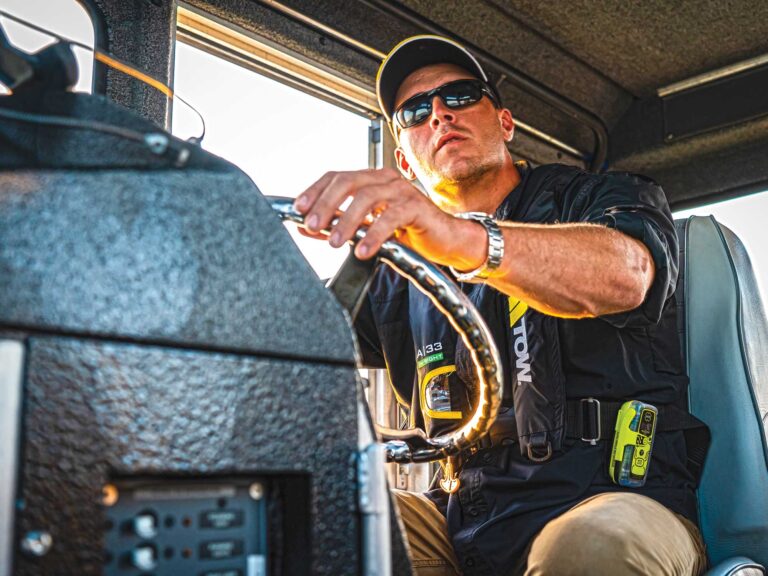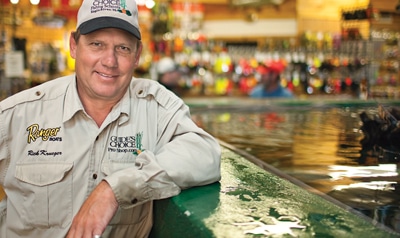
The fish is suspended in full view. It is motionless, is not blinking and is seemingly without care. Its menacing teeth are visible, exposed on the business end of a torpedo-shaped body, and just enough to show that, if given the opportunity, it would dispatch with any nearby fish or game of lesser size without prejudice. It is exactly what I’d hoped to see of the apex predator of freshwater game fish, the muskellunge. It’s just that I didn’t anticipate seeing it through a plate of tempered glass.
“I built this aquarium for 26,000 bucks,” says Rick Krueger, “just so I could watch these stupid fish from my office.” Krueger is the owner of Guide’s Choice Pro Shop in eagle River, Wisconsin, and living proof of the effect muskies have on the people who chase them. He keeps a few muskies in the tank and feeds them live suckers for show. It’s a good place to stop for this mission.
I’ve had it in my head to catch a muskie for some time. But I’ve faced two obstacles. One, I live near New York City and do most of my fishing in salt water. Two, you don’t just go out and catch a muskellunge. you earn it. They are called the fish of 10,000 casts. It takes the average angler about 60 hours of hard fishing to catch a single muskellunge. That’s five 12-hour days. I’ve given myself three to get this done.
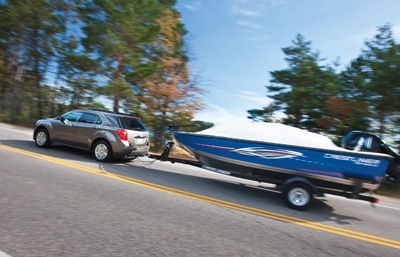
Day One: The Recon
The town of Eagle River, with its classic Main Street straight out of a Norman Rockwell painting, sits wedged between two national forests, not far from the upper peninsula of Michigan. About 2,000 people live in town, but that number swells with urban vacationers from Chicago and Milwaukee in the summer, and with muskie fishermen in the fall. They come to play on the Eagle River Chain of Lakes, a nine-lake system with more than 3,600 acres of fresh water. This is Muskie Central, USA. That three muskie-oriented tackle shops not only exist but also thrive in a 2½-square-mile area is testament to the allure of the big fish.
I’ve towed a Crestliner 1850 Raptor here from Minneapolis with photographer John Linn, and our first stop upon reaching town is Tadpole’s Bait and Tackle on Wall Street. Tadpole’s is a log-cabinesque structure connected to a nursery. It’s across the street from Eagle Sports Center and exactly 0.8 mile down the road from Guide’s Choice Pro Shop. We walk in past the racks of hunting fatigues and spy Todd Powell, the owner of Tadpole’s.
“So you guys want to catch a muskie?” he says, looking up from helping someone with camouflage. “The conditions are tough, but I can take you guys in the morning.”
The offer is tempting. Our mission, though, is DIY.
“Thanks,” I reply, “but we’d really like to go it alone.”
We’re led into a room covered with fishing paraphernalia — even the ceiling has a rack to display new rods. We’re getting the real deal now. We encounter two diehard muskie anglers perusing the latest $30 crankbaits; one has on a black jacket that says “Flatlanders Chapter: Muskies Inc.” They, too, are looking for advice. Powell leans against an aerated baitwell and rubs his goatee.
“You need to fish a live sucker,” he says. I think of the suckers that didn’t stand a chance in Krueger’s tank. Powell hooks us up with rigs and four live suckerfish. At 16 inches and with girths the size of hero sandwiches, they’re bigger than some game fish. But with their macaroni lips and slimy carriage, they get no respect. They are bait.
I’ve got a 7-foot Shimano Compre rod with a Curado 300 reel spooled with 50-pound braided line. For alternatives to the suckers, Powell hooks us up with some giant lures, including one called a Beast Teaser, and then takes us outside to his casting pond to show us how the lures swim. I imagine what it’s going to feel like chucking one 10,000 times. “The casting,” Powell says, “will beat you up.”
The giant aquarium is the first thing you see when you walk in the door at Guide’s Choice Pro Shop. A pike and several large crappies warily share the tank with the resident muskie, all of which Krueger caught. Krueger, who also runs a muskie fishing school, has been guiding for 30 years. He’s known locally as “Ranger Rick,” and any angler within a few hours’ drive of his shop is familiar with the name. “I’ve pretty much made my life muskie fishing.” He means it too.
“Is there one kernel of wisdom you can share with a rookie?” I ask.
“You can’t make a muskie mad,” Ranger Rick tells me. “It has no emotion. You can only make it decide to eat or not.”
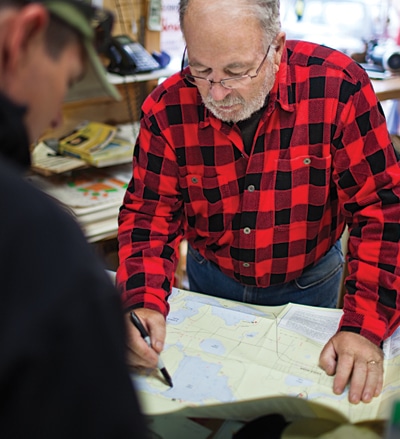
Day Two: The Attack
The weather report is not good: a high of 42 degrees with a 20 to 25 mph north wind that will make it feel like 32. We’ve been told to start fishing mid-morning with the suckers.
Faye’s Dinky Diner is a local culinary institution in downtown Eagle River, so John and I make that our first stop of the morning.
“Are you all from Chicago?” our waitress asks.
We tell the waitress (who may or may not be Faye) we’re here to go muskie fishing. One of the locals overhears.
“They had a tournament last week,” he says. “Caught most of the fish in Catfish Lake.” We realize if we’re going to find Catfish Lake, we’ll need a chart. Off to the third tackle shop.
The owner of Eagle Sports Center, George Langley, has been guiding for 35 years. He’s in the back organizing muskie lures. When I introduce myself, he doesn’t look up from his work.
“So,” I ask, “how should we go about catching a muskie?”
Langley looks at us over his glasses and recites a famous muskie line: “They’re either shallow, deep or somewhere in between.”
He tells us to fish the weed edges with bucktails, like the Beast Teaser, and if that doesn’t work, he says to run a bulldog, a large soft-plastic bait, out deep.
Langley marks up a chart with a pen, noting good spots to fish and to find shelter from the north wind. Without the map, we’d be lost — 3,600 acres is a lot of ground to cover. While folding the map, I notice Langley is credited with helping in its creation. I figure we’re in good hands.
Time to get after it. We dump the suckers in the livewell and trailer the Crestliner to the ramp about five miles out of town. Ours is the only trailer in the lot. Langley marked the half-mile-long shelf just west of the ramp as a prime spot. I bomb the bucktail for our first cast. With every cast comes the hope that our lure will meet up with a fish. With the trolling motor we work our way around the edges of eagle Lake, casting and casting. And casting and casting.
The summer cottages that dot the shoreline are closed up. We cast toward empty boathouses and lawns blanketed by felled leaves. Muskie fishing is a lonely business.
The wind picks up and blows us off the water by dusk, fishless. We estimate we’ve made more than a thousand casts, without a single bite. Only 9,000 more to go. Or 52 more hours.
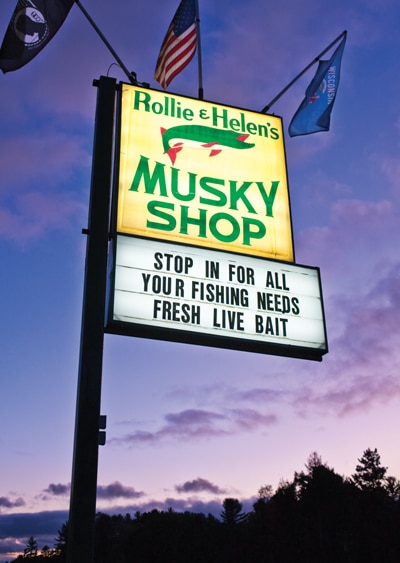
There’s a fourth place: Rollie and Helen’s musky Shop in Minocqua, about an hour’s drive away. It’s open until 9 p.m., and we’ll take all the advice we can find. The walls of Rollie and Helen’s are adorned with thousands of lures, some as pricey as $75.
“I got a 37-incher this morning,” Colby, the kid working the cash register, tells us. “Deep, at around 10:30.” muskie fishermen, we notice, talk in terms of inches and time. (“I got a 44-incher at 2:30,” another guy told us at a gas station.)
Jim Stewart, the owner of Rollie and Helen’s, comes over to talk. He doesn’t have the grizzled guide look of the others. With his easy smile, low-key demeanor and red hoodie, he could pass for a youth soccer coach. But then he talks muskie and you know he’s an addict like the rest of them.
“Guys have been catching them shallow,” he says, “close to shore.” His go-to lure? a shallow-running jerkbait. “A guy got a 42-incher on one in two feet of water.” He didn’t know the time. “The best advice I can give you,” he adds, “is to keep trying, and try different things until one works.” We hope we’ll use it to nail a 48-incher by 8 a.m.
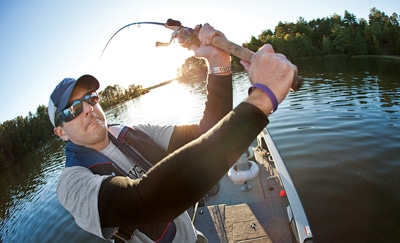
Day Three: The Cast-a-Thon
At first light a thick frost covers the grass. The sun rises strong with the promise of hooking a fish. The wind has died to a whisper. More comfortable for us, but the conditions don’t bode well for hooking up. “A sharp temperature drop will cause turnover,” Langley had told us. He meant that the water at the top of the lake cools and becomes dense enough to sink, pushing warmer water to the top, literally flipping the water over. The process can discombobulate the fish, giving them lockjaw.
In Catfish Lake, the sight of the alleged tournament success, we start bombing lures. We fish shallow, deep and everywhere in between. The muskellunge of the area are not forthcoming. There are eight other lakes to choose from, plus the river. We work the Crestliner through Voyager, Eagle, Scattering Rice, Otter, Duck and Yellow Birch. We have until sundown to squeeze in 8,500 more casts — or the equivalent of 48 hours into about six.
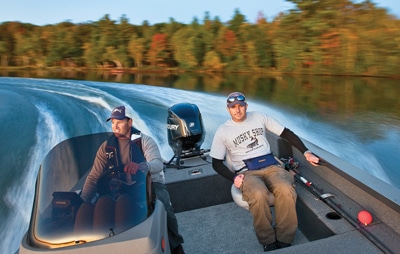
Operating a lightweight aluminum boat takes some adjustment compared with running the heavy fiberglass center console I fish in salt water. With a 175 hp Mercury Verado, the 1,470-pound boat jumps quickly to throttle movements. It’s also more susceptible to wind. But navigating from a chart is exactly the same as anywhere, as is following the red and green markers.
The casts keep piling up, and my shoulders feel like I’ve been swinging a sledgehammer. We still have some light left, though, so we bomb lures along the vegetation, hoping to coax one muskie out of hiding. A swirl, any sign of life, would be encouraging. Even a northern pike would lift our spirits. Nothing.
With the sun fading and the thermometer with it, we surrender. We figure that despite our blitzkrieg efforts, collectively we came up about 5,000 casts short.
When organizing the gear in the boat a little later, I open the livewell and see something moving around. Oh, yeah, the suckers. In our effort to rack up 10,000 casts, we forgot to set the live bait. My face suddenly feels warm and red. Smuggler’s, on Railroad Street next to the Dinky Diner, was supposed to be our spot for a victory beer. Instead, we sip on Leinenkugel’s and take stock of our trip. Two fishermen from Chicago pull up next to us at the bar. They look exhausted but happy. “Tough out there today,” the bearded guy tells us.
“Tough couple of days,” I reply.
“Got a 38-incher,” the bearded guy says, “at 5:30.” We fished the same water at the same time. What gives? Of course, they took that muskie on a sucker.
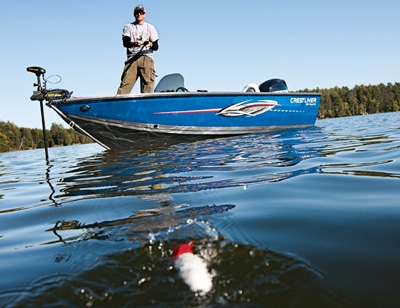
The Mettle of Metal
Fiberglass boat owners tend to look down on small aluminum boats as second-class citizens, but many die-hard aluminum devotees will never use anything but. Here are five reasons to go with aluminum.
Weight – Aluminum boats are typically lighter when compared with fiberglass models and require less power and fuel to run than do fiberglass boats of equivalent size. Plus you can get away with a smaller tow vehicle.
Maintenance – Fiberglass is more susceptible to fading from ultraviolet light, and if you don’t maintain it, the boat will look chalky and faded in a few seasons. With aluminum you can typically just rinse down the boat.
Durability – Bang into a dock or a rock in a fiberglass boat and you’ll wind up with a deep scratch or a chunk out of the gelcoat. A dent in aluminum is often easier to fix.
Tradition – In fresh water, fiberglass is associated with runabouts and cruisers, but the hard-core anglers seem to all use aluminum. Why swim against the current?
Resale – It’s related to tradition, but if you plan on upgrading in a few years, buy a boat that people in the area would want to buy from you one day. If everyone’s using aluminum, they’re not going to buy your used glass hull, no matter how awesome it is.
Consider the Muskie
Bass are mainstream and trout have snob appeal, but there is no more worthy or difficult adversary in freshwater fishing than the muskellunge. It is not a fish for the casual angler.
Muskies are associated with the Midwest but can be found in points south. The state record fish in North Carolina, a 41-pounder, had a 5-pound carp in its belly.
The name Muskellunge supposedly derives from the Ojibwe Indian word maashkinoozhe, which now translates as “ugly pike.”
A 40-pound Female muskie can produce about 200,000 eggs during spawning — a good argument for catch-and-release fishing.
In 1955, Wisconsin named the muskellunge its official state fish.
A Muskie attacks its prey by targeting the eyes and head and trying to swallow it whole. Its many large teeth are used for holding its prey before swallowing rather than for chopping it up.
The Muskie’s diet consists mainly of other fish, and even other muskies. But muskies have been known to eat ducklings, muskrats, mice and, as dubious legend has it, small dogs.





